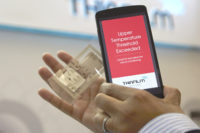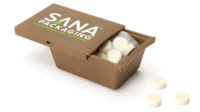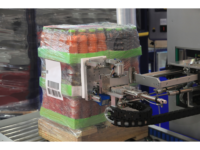Imagine a future where technology makes it possible to verify the shelf life of your favorite products, donate to charity by tapping your smartphone on the sleeve around a bottle of water or access recipe videos and full nutritional analysis from a pouch of microwaveable rice. These types of smart packaging are not something from the realms of sci-fi. No, they are, in fact, perfectly achievable today and fast approaching the point where they will be economically viable for FMCG companies.
New data from Research and Markets shows the global smart packaging market is likely to reach approximately $52 billion by 2025. What’s more, the broad flexible electronics market is projected to reach a value of $13 billion by 2020. It’s clear these two trends are set to converge. Rigid packaging with embedded NFC is already becoming more common, and this is a trend that is inevitably going to extend to the flexible packaging arena as well.
NFC can enable a range of interesting interactive features for consumers. For instance, information about promotional offers, recipes and interactive experiences, such as videos and games, can all be accessed with a quick wave of a smartphone.
For example, in Russia this past September, labels on promotional bottles of Miller beer came with built-in NFC tags for its “change the music of the future” campaign. Users could tap on the tags inside the label with a smartphone and go straight to the company’s website, where their face is scanned for emotion recognition. Artificial intelligence (AI) then detects changes in the user’s mood and suggests music accordingly through the website.
And it’s not just consumers who can benefit from this technology. There are a whole host of advantages for the FMCG manufacturers too, whether this is helping gather marketing information on customers or checking that products have not been counterfeited or damaged in transit.
A Flexible Future
Flexible packaging shows particular promise in terms of potential use cases. According to Aptar’s 2016 sustainability report, flexible standup pouches, which come with a spout for easy pouring, are one of the fastest-growing formats in food and beverage packaging. In fact, 75 percent of buyers of flexible packaging companies do so with an aim to specialize in food packaging. Imagine what the addition of NFC could do for this industry. Pouches of baby food could be made tamper-proof to reassure customers, diabetics could get useful information about the glucose content of their food and sachets of sauce could come with downloadable games or competitions, enhancing the consumer experience. Engagement with the user could, in fact, continue multiple times both during and post-sale, even up to offering the customer options for re-ordering the product when it has been used.
Critically, some of the NFC solutions currently being pitched into the packaging market are not particularly well-suited to flexible packaging. Traditional silicon-based solutions are brittle and require mounting on a semi-rigid substrate, which is obviously not ideal in flexible packaging. As an example of this, Frito Lay launched limited edition crisp packets during the Super Bowl earlier this year. The snacks came with simple breath analyzers integrated into the bags, plus an NFC tag so that customers could tap their smartphone against the bag to call an Uber ride home if they had been celebrating too heavily. Although a fantastic example of technology in packaging, the bags, which were otherwise flexible, had a rigid element in them to make all this possible. There are many types of flexible packaging where this solution would not be suitable.
There are companies in the market, however, that have developed flexible electronics technology for smart packaging. In theory, such technology could overcome these issues whilst also allowing for a greater range of form factors. NFC could be integrated into a wide range of flexible packaging formats, from bags to wraps to drink pouches and labels. It would also be more resistant to impact damage.
A Nickel or Less?
According to Steven Bagshaw, marketing executive at the Centre for Process Innovation (CPI), NFC technology needs to reach industry standards in terms of supply chain efficiency and unit costs. In fact, cost is the one overriding concern that overshadows almost all potential solutions. NFC has, until now, been reserved for premium or luxury items, or applied solely to promotional packs as part of a short-term marketing campaign. Everyday FMCG items have lower profit margins and, as such, could not support the extra costs of traditional NFC technology.
In fact, 16 years ago, professor Sanjay Sarma published a paper called “Towards the 5¢ Tag,” in which he set this as the benchmark for mass adoption and laid out how the price could be achieved. Although it is generally agreed that the price will eventually fall further than 5 cents, there is no official magic number in terms of how low this price needs to go to tip the FMCG market, although many expert groups now seem to be settling on the notion that the tags need to be 1 cent or less for the proliferation of NFC into everyday items to finally begin.
PragmatIC
www.pragmaticprinting.com




